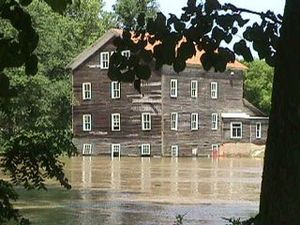Eel River (Wabash River tributary) facts for kids
Quick facts for kids Eel River |
|
|---|---|

Collamer Dam
|
|
| Native name | Kenapocomoco / Kineepikwameekwa Siipiiwi |
| Other name(s) | L'Anguille River |
| Country | United States |
| State | Indiana |
| Physical characteristics | |
| Main source | Huntertown, Indiana |
| River mouth | Wabash River Logansport, Indiana |
The Eel River is a 94-mile-long river in northern Indiana, United States. It flows into the Wabash River. From there, its waters travel to the Ohio River, then the Mississippi River, and finally reach the Gulf of Mexico.
The Eel River starts near Huntertown in Allen County. It then flows southwest through Allen, Whitley, Kosciusko, Wabash, Miami, and Cass counties. It joins the Wabash River at Logansport.
The Miami people, who lived in this area long ago, called the river Kineepikwameekwa Siipiiwi. This means "river of the snake fish." When Europeans arrived, the English later called it Ke-na-po-co-mo-co. This Eel River is the northern of two rivers with the same name in Indiana.
Contents
How the Eel River Formed
A River Shaped by Ice
The Eel River began forming at the edge of a giant ice sheet. This ice sheet was part of the Wisconsin Glacier, which covered much of North America. As the glacier melted and moved, it shaped the land.
Later, another part of the glacier, called the Erie Lobe, covered the river. When this ice melted, the Eel River formed again. It was once connected to what is now Cedar Creek.
A River's Course Changes
Glacial meltwater also flowed into the ancestral Eel River. This water came through a "tunnel valley" now known as Cedar Creek Canyon.
Over time, sediment from the canyon blocked the Eel River's path. The amount of meltwater also decreased. This forced the upper part of the Eel River to change its course. It started flowing into the canyon, creating today's Cedar Creek. This is an example of "stream piracy." It means one river "stole" water from another. This change shifted a large area of land from the Eel River's watershed to the St. Joseph-Maumee watershed.
Early People and Explorers
The Miami People's River
Rivers were very important for early people. They provided food, water, and ways to travel and trade. The indigenous peoples settled along these waterways for thousands of years.
The Miami people, who spoke an Algonquian language, lived along the Eel River. They called it Kineepikwameekwa Siipiiwi or Ke-na-po-co-mo-co. This name means "river of the snake fish."
French Explorers Arrive
Later, French explorers came to the area. They also used the rivers for travel. They called the Eel River the Rivière L'Anguille, which means "Eel River" in French.

Important Historical Events
A Border and Conflicts
Before the United States fully controlled the Northwest Territory, the Eel River was an important boundary. It separated the Potawatomi tribe to the north from the Miami tribe to the south.
For many years, French and British forces also competed for control of this area. This happened before the American Revolution. After the Revolution, the U.S. fought several battles with Native American tribes. These conflicts are sometimes called the Northwest Indian War.
Battles Along the River
In November 1780, a French group led by Auguste Mottin de la Balme tried to take a British trading post on the Eel River. This was near where Columbia City is today. However, the Miami warriors, led by Chief Michikinikwa, defeated them.
On October 19, 1790, Chief Michikinikwa's warriors surprised a U.S. force. This happened in the lowlands of the Eel River, southeast of today's Churubusco. The U.S. force, led by Colonel John Hardin, was almost completely destroyed.
Another battle took place on the Eel River on August 7, 1791. General James Wilkinson destroyed the Miami town of Kenapacomaqua. This town was about 6 miles upstream from present-day Logansport.
In September 1812, Colonel James Simrall followed orders from General William Henry Harrison. He attacked Miami farms and villages along the Eel River in what is now Whitley County. He also defeated a Miami force that fought back.

